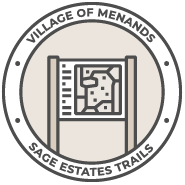Henry Manning Sage was born in Albany, NY in 1868 to Dean and Sara Sage. In the last half of the 19th Century, the Sages owned a large lumbering and land management enterprise which controlled over one million acres of valuable forested lands in several states. The Sage Company leased numerous slips in the famous Lumber District of North Albany. In the 1890’s Henry M. Sage purchased the old Isaac Chapman Estate on the south side of Menand Road and replaced the old Chapman home with an English style country mansion designed by noted Albany architect Marcus T. Reynolds. The home was referred to as “Fern Brook”. Additional land purchases extended the Sage property southward to present day Wards Lane.
The Sage Estate land was divided by a deep gully cut into the shale bedrock over time by a small stream called the Rutgers Kill, but known locally as Nuckols Creek. A 200 foot long concrete and stone bridge called “Rainbow Bridge” (because of its arches) was constructed by Henry M. Sage to access lands on the southern portion of his property where orchards and hay fields were located. Besides its grandeur, “Fern Brook” was actually a working farm including a dairy barn, sheep, flower and vegetable gardens, a caretakers home and carriage house, and at least two root cellar structures for cool storage. Henry M. Sage died in 1933. His 2nd wife Cornelia lived at the mansion until her death in 1972. Both are buried in the Albany Rural Cemetery.
This section of land immediately south of the Rutgers Kill was obtained by the Village of Menands with the intent that it remain forever wild. The bridge was demolished in the 1990’s. The area before you is now known as the Sage Estate Trails consisting of 65 acres of native forest and paths that sometimes follow old carriage and wagon routes of Henry M. Sage’s Fern Brook Estate.
